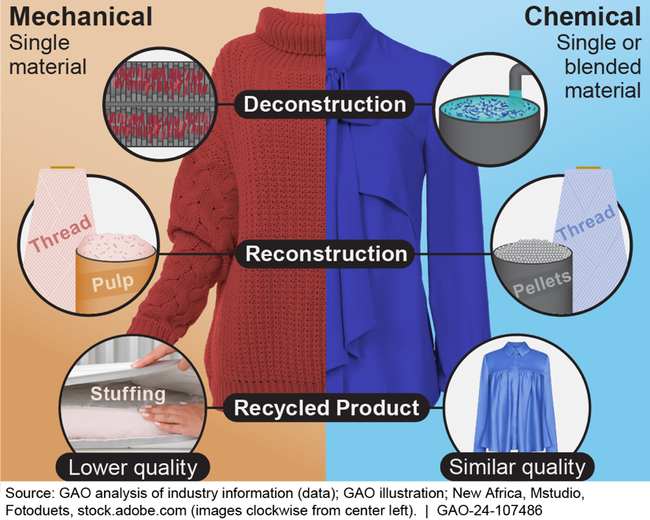Science & Tech Spotlight: Textile Recycling Technologies
Highlights
Why This Matters
The U.S. is one of the top consumers of textiles in the world, and clothing brands produce approximately twice the amount of clothing today compared to 2 decades ago. Driven by fast fashion—the mass production and consumption of low-cost clothing—consumers are now wearing clothes fewer times before disposing of them. This has significant environmental implications, including discarded clothing being the largest source of household textile waste. Recycling can help divert textile waste from landfills and into useful applications.
Key Takeaways
- Mechanical and chemical textile recycling technologies are limited by a lack of supporting infrastructure.
- Recycling technologies that preserve textile quality and can separate blended materials are still in development.
- Obstacles to widespread textile recycling include material suitability, high costs, and environmental considerations.
The Technology
What is it? Many textiles, including clothing, upholstery, carpets, and similar materials, can be recycled to extend their useful life and reduce waste. Mechanical and chemical recycling can deconstruct and reprocess textiles discarded during the manufacturing process (pre-consumer) or after consumer use (post-consumer). Recycling approaches differ based on the material, and the quality of recycled products can vary.
How does it work? Mechanical recycling involves physically deconstructing fibers through methods such as shredding, crushing, or melting, before reprocessing fibers back into yarn. Mechanical processing leads to weaker fibers and lower quality textiles that have limited use, such as furniture stuffing or insulation. Mechanical recycling is most effective for single material textiles (e.g., 100 percent cotton). It is less effective for blended materials because the recycling process further degrades the quality of the resulting material.
Chemical recycling reduces textiles to their basic molecular building blocks using chemical solutions, then rebuilds them to produce fibers of similar quality. The required chemical solution differs based on textile material. As a result, current chemical recycling methods are typically not effective for blended materials. Novel approaches using enzymes can separate some blended materials. For example, certain enzymes can separate cotton and polyester fibers at the molecular level. The fibers are then reprocessed into usable material.

Fig. 1 Mechanical and Chemical Textile Recycling
How mature is it? Mechanical recycling technologies have existed since the Industrial Revolution. However, mechanical textile recycling is limited due to modern challenges such as the extensive use of blended materials. Improved labeling that contains a breadth of details (e.g., composition, production process, and recyclability) could help address this issue but is not widely implemented. Chemical textile recycling is not currently available for widespread use. Such technologies have been successful in the laboratory and small-scale settings.
Sorting is an important prerequisite for recycling, but high-speed automated sorting systems are still under development. For example, infrared scanners could identify textile composition to help sort materials. Artificial intelligence and robotics could be used to sort material with high accuracy, but such technologies are not ready for wide-scale implementation.
Opportunities
- Reduce waste. Textile recycling could reduce waste that enters landfills and oceans or is incinerated. This waste sometimes produces microplastics or other substances that can harm the environment and humans. Recycling could also mitigate other environmental consequences of new textile production, affecting areas such as land use, soil erosion, and fossil fuel consumption.
- Support a circular economy. Some chemical recycling technologies yield high-quality fibers that are indistinguishable from new fibers. This could enable a low-waste system in which few raw materials are needed to recycle or produce textiles. Textile recycling could also shift demand toward new skills related to design, manufacturing, collection, and sorting.
Challenges
- Material complexity. Some materials are difficult to separate and recycle. Finishes and dyes may not easily degrade and can impede recycling. Buttons, zippers, and other parts can disrupt the process and need to be removed. As previously mentioned, blended materials are not suitable for recycling but are present in most clothing.
- Infrastructure. Current equipment and systems are not suited for high-volume production. Textile collection is difficult to integrate with curbside waste collection because the textiles can mix with other items, making them difficult to recycle. A separate collection option could address this issue but would be logistically complex.
- Cost. Recycled textiles are more expensive to produce and purchase than those derived from new materials.
- Environmental considerations. Textile recycling can have fewer negative environmental effects than producing new textiles. However, some technologies require high levels of energy or water consumption. Recycling can be combined with other sustainable approaches that are less resource intensive, such as reusing, repairing, and repurposing textiles, to reduce waste.
Policy Context and Questions
- What standards might help improve the suitability of textiles for recycling?
- What safeguards should be taken to minimize the environmental hazards of textile recycling?
- What technological improvements and infrastructure are needed to facilitate widespread textile recycling?
Selected GAO Work
Advanced Plastic Recycling, GAO-21-105317.
Federal Efforts to Advance Recycling, GAO-21-87.
Selected References
Jeanger P. Juanga-Labayen, et al., “A Review on Textile Recycling Practices and Challenges,”Textiles, vol. 2 (2022), doi: 10.3390/textiles2010010. Damayanti Damayanti et al., “Possibility Routes for Textile Recycling Technology,”Polymers, vol. 13, no. 3834 (2021), doi: 10.3390/polym13213834.
For more information, contact Karen L. Howard, PhD at (202) 512-6888 or howardk@gao.gov.
